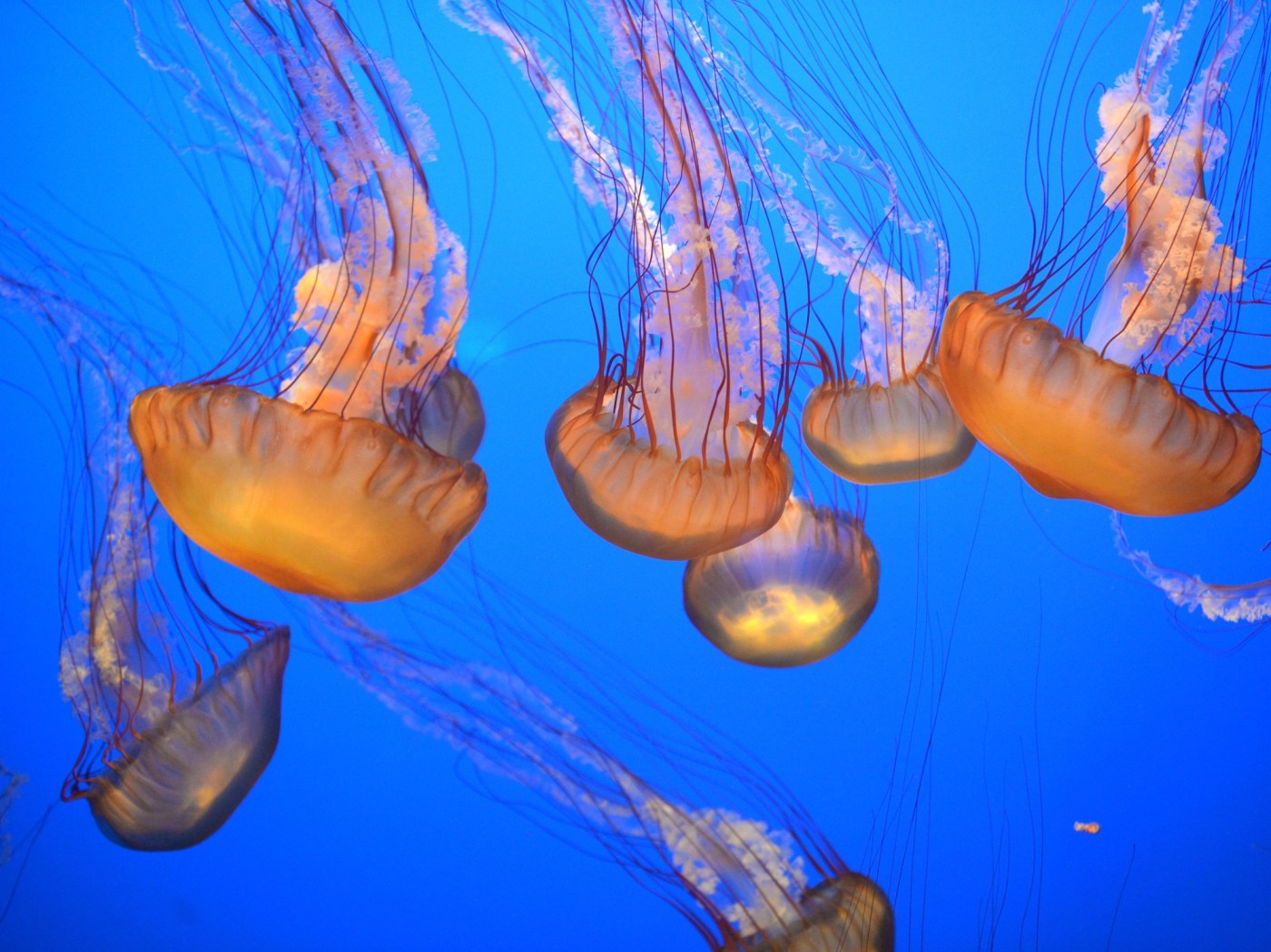MONTEREY – As marine biology students and teachers, the braintrust that would later become founders of the Monterey Bay Aquarium were well acquainted with aquariums and zoos around the world.
But looking at the abandoned Hovden Cannery in the 1970s, perched over the bay on Cannery Row, they decided to take a different approach to what had been done before.
“It was a pretty radical idea to decide to do a whole aquarium just about this bay, because aquariums and zoos both were historically created as menageries. They were collections of animals from around the world,” said Aquarium co-founder Julie Packard. “And we were told by various colleagues at the time, how can you have interesting exhibits if you don’t have any colorful tropical fish, or a lot of aquariums of dolphins, for example. You need marine mammals or marine mammals shows. We had a totally different idea in mind.”
From the beginning, the Monterey Bay Aquarium was different from its counterparts – and it’s not just because of the animals they chose to exhibit. Forty years since opening, the Monterey Bay Aquarium continues to run against the current, but also inspire other aquariums and zoos to follow.
“Founded by biologists not interested in marketing,” said Hank Armstrong, the Aquarium’s first public relations director.
Creating new exhibits, in new ways
Packard explained the invertebrates, algae and the “small, squishy thing” typically don’t get a lot of focus in aquariums but thanks to its location, the Monterey Bay Aquarium was able to highlight these stories. “We are able to pump very rich, unfiltered seawater into our building,” unlike inland aquariums that use synthetic seawater. While the rock walls may be artificial, the things growing on it have come through the seawater system organically. “That’s why it looks very natural.”
Paul Clarkson, the Aquarium’s director of husbandry operations also highlighted the uniqueness of Monterey’s approach to exhibits – especially with the Kelp Forest tank.
“Back in 1984, conceiving of a live kelp forest exhibit at that time was unheard of. There was less than unanimous confidence that it was going to work out,” he said. “Some of the sentiment was one: how on Earth are you going to do that? Nobody’s been able to do that before. And two: who’s going to be interested in that? Nobody wants to see kelp forest, people want to see dolphins and sharks.”
RELATED: Monterey Bay Aquarium: Providing otter love through surrogacy program
The institution took a massive risk, basing one of their central and biggest tanks on the kelp forest, but it paid off. “Here we are 40 years later, it’s one of our most popular and most recognizable exhibits,” Clarkson said. “It’s a remarkable opportunity for visitors to see what’s right off our back deck here,” and 40 years later, it is still considered a groundbreaking exhibit people won’t get an opportunity to see anywhere else.
Clarkson also shared a similar story for the jellyfish exhibit. When the Monterey Bay Aquarium opened, no public aquariums in the United States had jellyfish tanks. Many aquariums thought visitors wouldn’t be interested in them and instead would want to see the “big, charismatic animals,” like sharks or otters.
The first jellyfish exhibit in the United States was brought to the Monterey Bay Aquarium in 1985. Clarkson explained the Aquarium again took another big risk, creating their first temporary exhibit of jellyfish in the late ’80s and, like the Kelp Forest exhibit, it was incredibly popular with visitors.
“It inspired lots of other American aquariums to invest in jellyfish husbandry and care and exhibits,” Clarkson said. “To this day, you can see the influence of Monterey Bay Aquarium jellyfish work from the ’80s all throughout aquariums in the state and the world. A lot of this work has inspired others.”
Monterey is also very different from other aquariums structurally. Walking into the Aquarium, you are immediately greeted with massive windows and a breathtaking view of the bay.
“I mean, the best exhibit here at Monterey Bay Aquarium isn’t even in the Aquarium,” said Packard. “It’s looking out at the bay.”
Everyone agreed the building design would have a big focus on the outside and allow in lots of natural light, something vastly different from the traditionally dark aquarium.
“You can experience (the animals) inside the building and learn about them, and then you can go outside and see them in the wild, which is remarkable,” Packard said. “There’s no other aquarium here in the U.S. that has that.”
A difference in mindset and a commitment to ocean conservation
Perhaps what separates Monterey the most from other aquariums was the founders’ mindset. Instead of going for the traditionally big-ticket aquarium attractions and guaranteed money-makers, the founders were committed to telling the story they wanted to tell, how they wanted to tell it and educating Aquarium guests on ocean conservation.
“What motivated them was not revenue in any way shape or form,” said Armstrong. Instead, the Aquarium was motivated by protecting the ocean and educating guests on how they too can make an impact.
The Aquarium’s dedication to ocean conservation was instrumental in helping protect the California coast and getting global policies put in place to protect the ocean.
RELATED: A mission to inspire and educate: Julie Packard reflects on Monterey Bay Aquarium’s 40 years
“The aquarium was absolutely essential to building a case for making Monterey Bay National Marine Sanctuary,” said Leon Panetta, who represented the region at the time in Congress and played a large role in establishing the Sanctuary status. “I was able to turn to Julie Packard and the researchers and get the backup that I needed in order to make a case for why Monterey Bay was unique enough to make it a marine sanctuary.”
“I think the aquarium and Julie Packard have been very important to the whole argument of why we need to have a strong national ocean policy, and why it’s important that we protect our oceans,” Panetta said.
Lura Migdal, the district manager of operations for SSA Group – the Aquarium’s embedded food and retail vendor – has worked closely with the Monterey Bay Aquarium for the last 10 years to eliminate single-use plastics from their cafe and stores.
“It has been 10 years of changes, which is awesome, that’s the cool part. You never stop changing,” said Migdal. “You’re always trying to make it better and make it more in line with the mission.”
All of the vendor partners the Aquarium works with have made commitments to zero plastic shipping. All of the food in the Aquarium’s cafe is sourced locally from California partners and small businesses, with about 35 partners in the county.
In the Aquarium stores, there is zero plastic packaging, no plastic toys and all of the plushes have used 100% recycled plastics since 2022. The Aquarium hasn’t had single-use bags in 20 years. But it extends further than just the Aquarium’s direct impact – they wanted to change the industry.
“The Maryland Zoo went plastic free in their retail after they heard we were doing it … A lot of our aquariums are bringing in the same products that we’re bringing in that don’t have the plastic, which is awesome,” said Migdal. “It’s huge to be able to make that impression.”
Migdal said she is always eager to help other aquariums, zoos and retailers make the same changes as Monterey to make their products and their businesses more sustainable, but is just as excited to talk about conversation on the individual level.
“This is something that we get to educate and hopefully change (guests’) mind on buying a plastic bottle the next time. That’s huge, to be able to say they came to the aquarium they saw this cool metal bottle or aluminum bottle, and that stopped them from buying hundreds and hundreds of plastic bottles. That would be the best part of my day,” said Migdal.
“All the work we’ve done here, we can share,” said Migdal. “We want everyone to know how to do it.”












